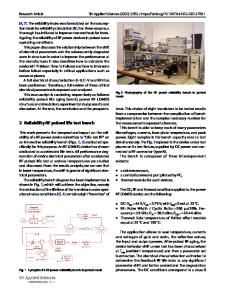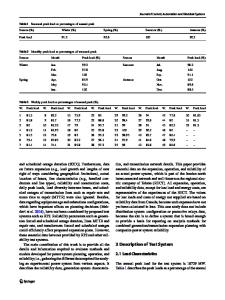Test reliability
- PDF / 218,810 Bytes
- 3 Pages / 612 x 774 pts Page_size
- 51 Downloads / 351 Views
PROBLEMS
OF METROLOGY
AND
MEASUREMENT
TECHNIQUES
TEST RELIABILIT~ I. P. Kopytov
UDC 621.3.089,6:519:006.012.5
The choice of test-reliability and accuracy indicators for measuring instruments has been discussed in many articles [i-i0] where the reliability of tests has been evaluated on the basis of probability characteristics. In [4-10], type II errors (undetected defects) are assumed to be represented by the probability of improper acceptance of an article referred to the total number of tested acticles. In the author's opinion, it is sometimes more convenient [9] for the customer if type II errors are defined as the probability of undetected defects referred to the number of accepted articles, since such an interpretation of errors provides a more specific characteristic of the quality of accepted articles delivered to the customer. Type II errors thus defined are calculated and plotted below, First, consider the methods used here and in certain other cited papers to calculate the errors. In [4-6, I0], the result obtained for test errors were decremented by a "negligibly small amount" -- 0.27%. This was done in order to account for the truncation of the practical distribution of the measuring instrument error at the P = 0.9973 level. However, for a tolerance Atech on the tested parameter, equal or greater than three standard deviations Otech of the tested parameter, due to production technology, type II errors (e.g., in case of normal distribution) do not exceed 0.27% for any measuring instrument error. Thus, the decrement of the obtained results by 0.27 is not reasonable. Obviously, this is responsible for the fact that in certain instances type II errors have become negative. The nomographs given in [7] for the determination of test errors are based on simplified mathematical considerations~ The essence of the simplification is that in the interval Atech • AMI, where AMI denotes the tolerance on the measuring instrument error, the parameter distribution function is assumed to be constant. For practical proportions between the tolerances Atech and AMI such an assumption can lead to considerable errors (e.g., for AMI/ Atech = 0.3 and Atech/Otech = 2, the error of calculations can reach up to 30%). Our calculations are free from these shortcomings. They were carried out for a combination of normal distributions of article parameters and of measuring instrument errors. Type II errors are defined as the probability of the occurrence of defective articles referred to the number of accepted articles; the measuring-instrument error distribution has b e e n a s s u m e d normally truncated at the 3OMi level; the deviation of tolerance on the tested parameter lies within zero and AMI.
fz,~
~o
z,o
/,o
t
z
J Ktec h
Fig. 1
2
~ Ktech
Fig. 2
Translated from Izmeritel'naya Tekhnika, No. 5, pp. 12-13, May, 1978.
0543-1972/78/2105-0609507.50
9 1978 Plenum Publishing Corporation
609
6 o,w
L ,v~z
~3 ~o,01 ~aa~
/
~,
,r
0
Ktech
2
Fig. 3
~/ftech
Fig. 4
The calculations were carried out using the we
Data Loading...











